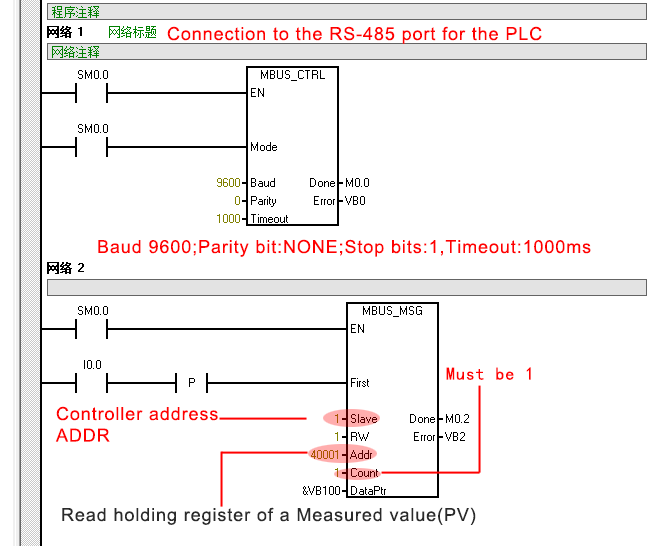the master controls communication between master and slave. A typical message consists of a request(query message) sent from the master followed by an answer(response message) from the slave. When master begins data transmission, a set of data is sent to the slave in a fixed sequence. When it is received, theslave decodes it, takes the necessary action, and returns data to the master.
| Signal transmission between the master and slaves is conducted in RTU mode. |
||
|---|---|---|
| Data bit length | 8-bit(Binary) | |
| Start bit | 1 | |
| Stop bits | 1,2 | |
| Parity bit | NONE | |
| Error check | CRC-16 | |
| When sending a command message from the master, set intervals of data configuring message to time longer than the 200ms time. if time intervals become time less than the 200ms time, the slave does not make a response. | ||
| 1.Read instrument parameters’ value: Measured value, control output value, etc. | ||
| Read holding registers | function code(03H) | query message(8bytes) response message(7bytes) |
| 2.Setting the instrument parameters’ value :set value, PID constants, etc. | ||
| Preset single register | function code(06H) | query message length(8bytes) response message length(8bytes) |
| KCM-9 KCM-8 KCM-9P Temperature Controller | |
|---|---|
| Example:The contents of a single holding register 1001H(Measured value) is the read out from slave address 1 | |
| Query message: | 010310010001D10A |
| explain: | 01(slave address)03(function Code)1001(register address)0001(quantity. The setting must be 1)D10A(CRC16) |
| Response message: | 01030200FD79C5 |
| explain: | 01(slave address)03(function Code) 02(Number of holding registers*2) 00 FD(holding register contents) 79 C5 (CRC 16) |
| Response value: | Measured value(SV) have one decimal place:00FD=253,is processed as 25.3 The position of the decimal point changes depending on the input range type Because the Modbus protocol does not recognize data with decimal points during communication |
| KCM-XJ4 XJ2 XJ16 Multi-Loop Temperature Controller | |
| Example: The contents of the four holding registers from 1001H T0 1004H(four channels’ SV) are the read out from slave address 1 | |
| Query message: | 010310010004D10A |
| explain: | 01(slave address)03(function Code)1001(frist registers address)0004(quantity. The setting must be between 1 and 4)D10A(CRC16) |
| Response message: | 01 030800 FD 00 FA 00 FC 00 FE20 BC |
| explain | 01(slave address)03(function Code) 02(Number of holding registers*2) 00 FD 00 FA 00 FC 00 FE(holding register contents,channel1~4)20 BC(CRC16) |
| Response value: | Channel 1SV:00FD(H)=>253 is processed as 25.3 ; Channel 2 SV: 00FA(H)=>250 as 25.0; Channel 3 SV 00FC(H)=>252 as 25.2 ;Channel 4 SV:00FE(H)=>254 as 25.4 |
| 1.Data is written into the holding register 0000H (set value address)of slave address 1 | |
|---|---|
| Query message: | 106000000FA0989 |
| explain: | 01(slave address) 06((function Code) 00 00(register address) FF38(wite data) C9 E8(CRC 16) |
| Response message | 106000000FA0989 |
| When input set value(SV) is -20.0,-20.0 is processed as -200,-200=0000H-00C8H=FF38H | |
| 2.Data is written into the holding register 0001H (ALM value address)of slave address 1 | |
| Query message: | 01 06 00 01 0B B8 DF 48 |
| explain: | 01(slave address) 06((function Code) 00 01(register address) 0BB8(wite data) DF 48(CRC 16) |
| Response message: | 01 06 00 01 0B B8 DF 48 |
| When input ALM set value(SV) is 300.0,300.0 is processed as 3000,3000=0BB8H | |
